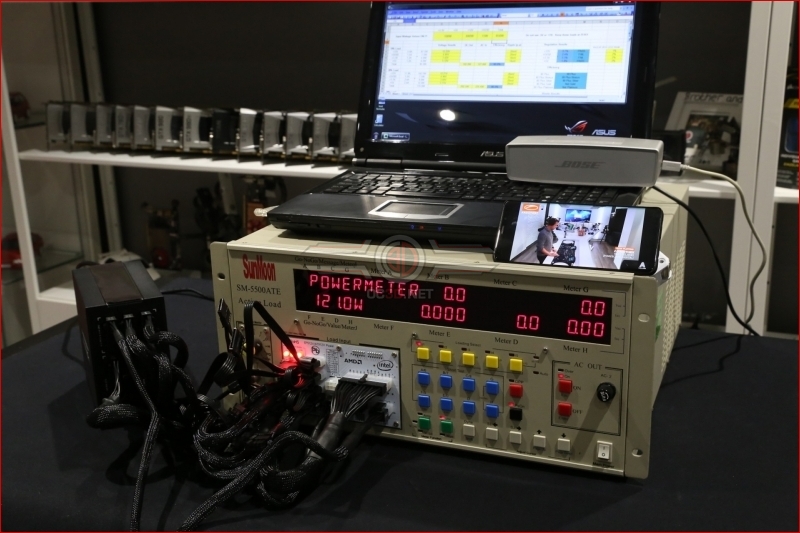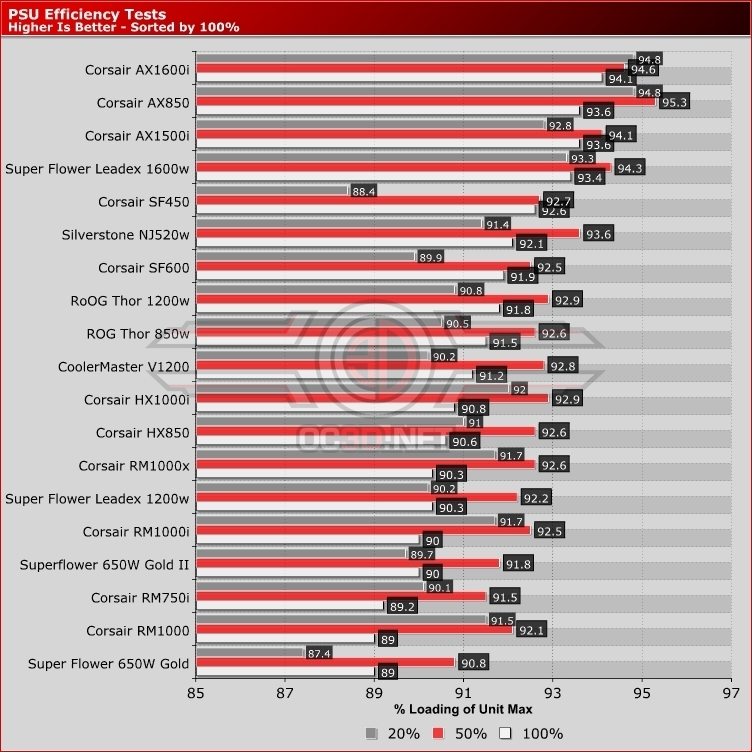Corsair AX850 850W 80+ Titanium PSU Review
Voltage Ripple and Efficiency Testing
When reviewing new power supplies at OC3D, we use our dedicated SunMoon PSU Tester, one of the most expensive (if not the most expensive) tools in the company’s arsenal. Here we can see exactly how well a unit can function, looking at its efficiency and power stability, giving us a more in-depth look at the performance of power supply than is possible when using it with standard PC components.
In our video review (next page), Tom will show you this unit in operation, with Corsair’s AX850 hitting its peak wattage output of 850W, showcasing the unit’s efficiency as we tested it at 20%, 50% and 100% loads.
When looking through our efficiency graphs our results are exactly as expected, with the AX850W sharing the top position with Corsair’s existing AX1600i. Both of these units feature 80+ Titanium ratings, explaining their performance similarities.Â
The benefits of increased PSU efficiency are twofold. The first, and most obvious, factor is power draw. 80+ Titanium power supplies will draw less power from the wall than lower-end units, resulting in lower electricity costs. These costs will be pretty minimal in the grand scheme of things, though they are nonetheless worth considering is electricity is expensive in your country.Â
Secondly, increased efficiency results in reduced heat output. It stands to reason that less wasted power will result in lower levels of heat production, as this is what happens to waste energy for the most part. This factor is what allows Corsair’s AX850 to stay in its passive fan mode for so long, making the unit extremely quiet for extended periods, even while under full load. Outside of efficiency improvements, heat output and noise levels are one of the most notable characteristics of ultra-high-efficiency PSUs.  Â
Voltage Ripple Tests
Voltage ripple is something that is often underlooked by consumers, being best be described as the stability of specific voltages that the PSU delivers. A PSU with bad ripple will see voltages vary a lot more, which in extreme cases can damage components or shorten their lifespan. Voltage ripple stability is one of the many reasons why you should buy a high-quality power supply and avoid anything that isn’t 80+ certified.
An important thing to note here is that none of the PSUs in this graph is “bad”, even bottom of the chart units like the original Corsair RM1000 bring usable within your system without any issue. Even so, having low ripple is an important factor to consider when purchasing a new PSU. Cleaner power will help extend the lifespan of your PC’s components by placing each product’s power circuitry under less strain. Even if the RM1000 is usable in a modern system, though we would expect all new high-end power supplies to perform better than this unit in terms of ripple. A lot has changed since the days of the RM1000.
Looking at the graph below we can clearly see that ripple is a strong point for the AX850, though it is worth noting that it isn’t breaking any new ground in this regard. The AX850 isn’t able to surpass the RX1000i for example, though marginally more ripple isn’t enough to consider this as a negative point.Â
When comparing the AX850 to recently reviewed units like the ROG Thor 850W, we can see that voltage ripple is an area where Corsair excels. While the AX850 cannot surpass some of Corsair’s newer offerings, it still sits amongst some of the best units that we have ever tested.Â






